
Dr Berg’s Beginner Guide to Healthy Keto & Intermittent Fasting Plan
Simple way to:
- Understand Keto principles
- Understand Intermittent fasting
- View what to eat and what to avoid
Dr Berg’s Beginner Guide to Healthy Keto & Intermittent Fasting Plan

What Is Healthy Keto® ?
Ketones are byproducts of fat burning. They can be used for fuel and occur when you lower your dietary carbs. Ketosis is the condition of this happening.
Healthy Keto® is the healthy version of ketosis. I coined this term to differentiate from traditional forms of the ketogenic diet for epilepsy, which use low-quality nutrients. So, Healthy Keto® is the version that uses quality, high-nutrient ingredients.
Why Does It Work?
The way one gets into ketosis is by reducing carbohydrates in the diet down to between 20 and 50 grams per day. Carbs stimulate the hormone that stores fat. This hormone is called insulin. In the presence of excessive insulin, the burning of fat is stopped cold. There are huge benefits to keeping insulin in a normal range. Carbs and frequent eating keep insulin high. To get into a state of ketosis so you can run on fat instead of glucose—and finally burn your own fat stores for fuel—you will need to start adapting your body to fat burning. You have to switch the body’s preferred fuel source. This can take anywhere from three days to two weeks.
But then, you want to get that fat off the body, right? This is the way to do it! You’ll actually lose weight while getting healthy and preserving lean muscle, so that you can burn more calories every day—unlike the muscle you lose by running on sugar and never tapping into fat burning.

What do I eat?
Most people need to consume between 1,200 and 2,100 calories per day, depending on the size of the body. We have a comprehensive keto food list where you can find an abundance of nutrient dense foods that are perfect for the keto diet.
The diagram below illustrates the recommended percentages of calories in relation to each other. These are rough percentages that can vary from person to person based on your body size and activity level.

Carbohydrates
You want to keep your carbohydrate amounts between 20 and 50 grams per day. Many people use 30 grams to keep it simple, but the lower the carbohydrates, the greater the fat burning. When we calculate carbs, we will subtract the fiber. This is called net carbs, and this is what we want to use as our 5 percent of total calories.
Also, remember that even foods that don’t seem to have carbs, such as nuts, seeds and hummus, actually do contain some carbs. Learn more about the best nuts for keto in this article. Berries have less sugar than other fruits. That’s why they’re allowable in small amounts on the keto program.
NOTE
Vegetables will not be a part of the carb equation. The exception is higher-sugar vegetables: squash, carrots, beets, peas, tomatoes and onions.
What does 20–50 grams of carbohydrates look like?
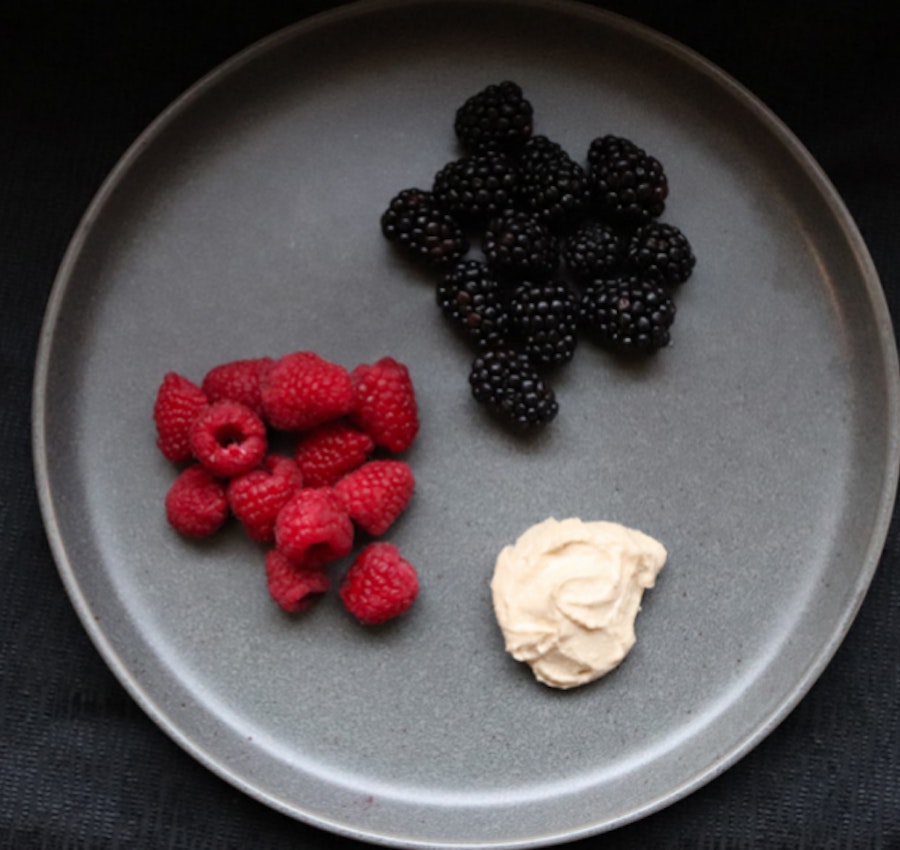
- 28 g hummus = 3 g net carbs
- 60 g raspberries = 7.5 g net carbs
- 70 g blackberries = 8 g net carbs
- Total: 18.5 g net carbs
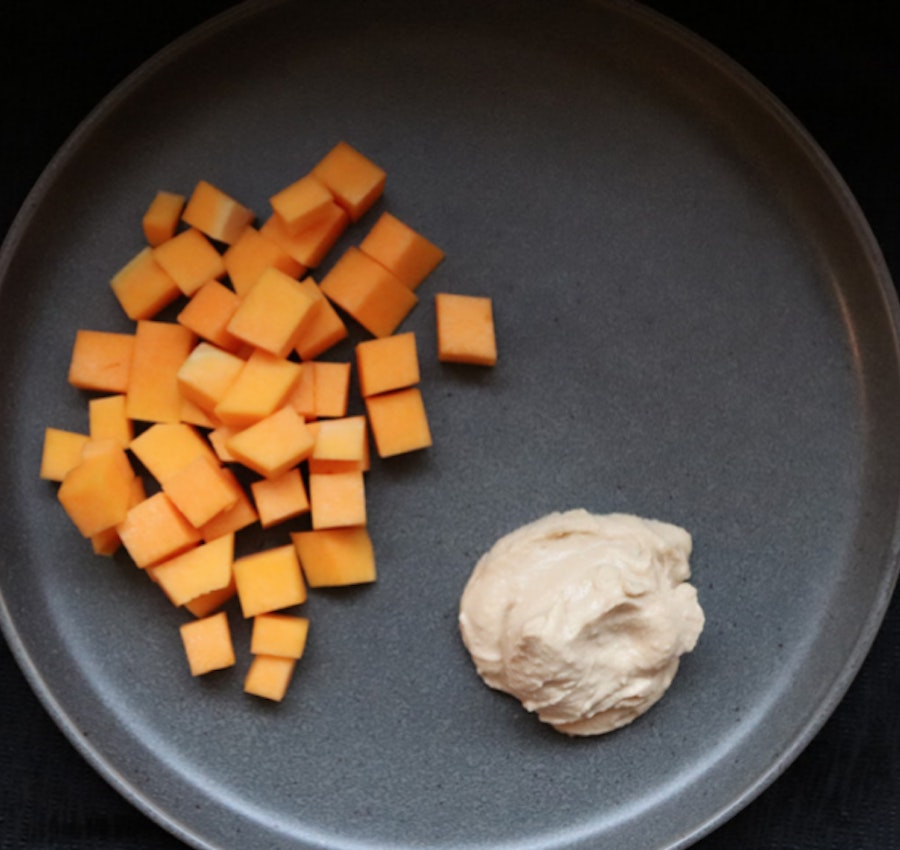
- 56 g hummus = 6 g net carbs
- 141 g butternut squash = 16 g net carbs
- Total: 22 g net carbs
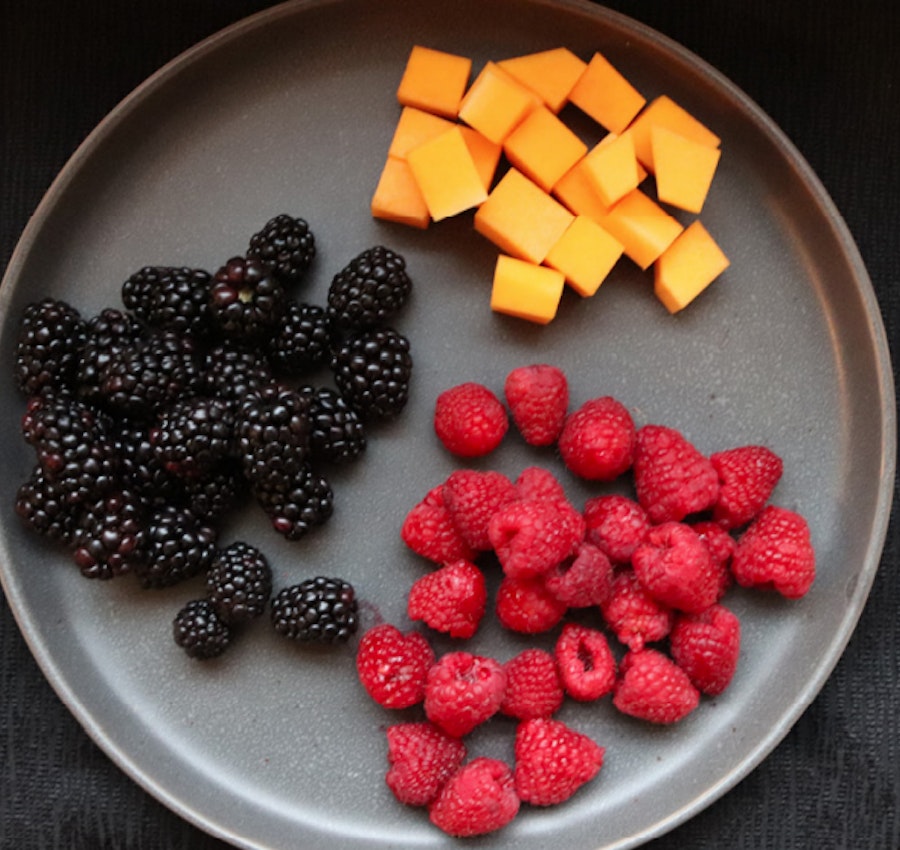
- 120 g raspberries = 15 g net carbs
- 123 g blackberries = 14 g net carbs
- 97 g butternut squash = 11 g net carbs
- Total: 40 g net carbs
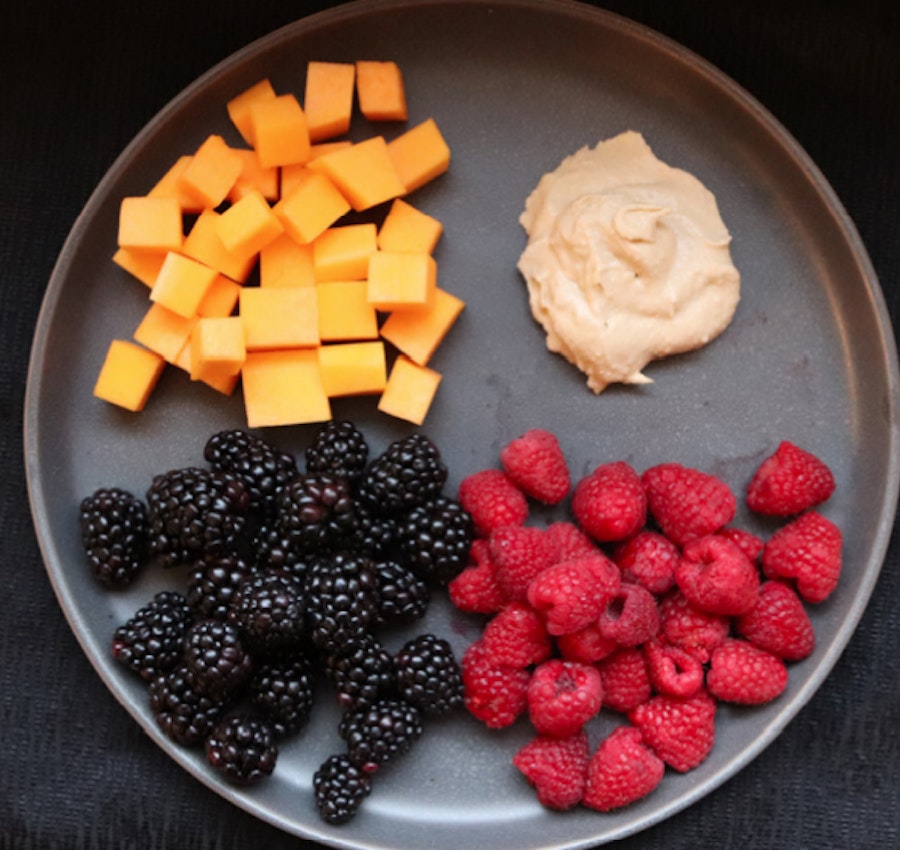
- 56 g hummus = 6 g net carbs
- 120 g raspberries = 15 g net carbs
- 123 g blackberries = 14 g net carbs
- 132 g butternut squash = 15 g net carbs
- Total: 50 g net carbs
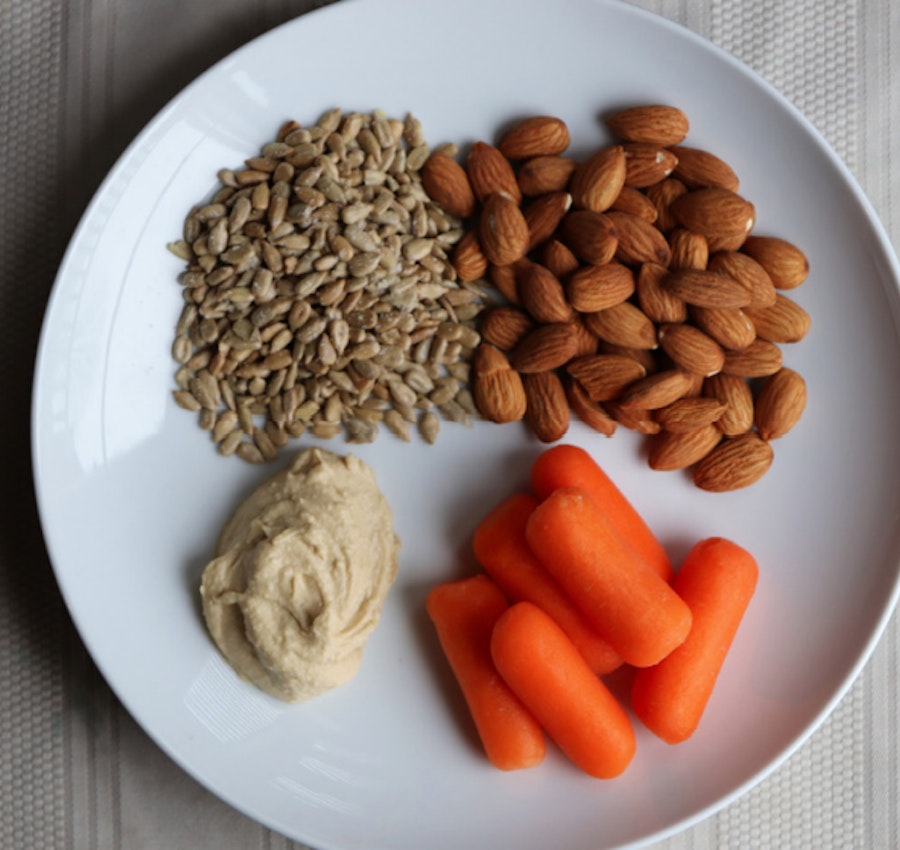
- 85 g carrots = 6 g net carbs
- 56 g almonds = 6 g net carbs
- 30 g sunflower seeds = 3 g net carbs
- 42 g hummus = 5 g net carbs
- Total: 20 g net carbs
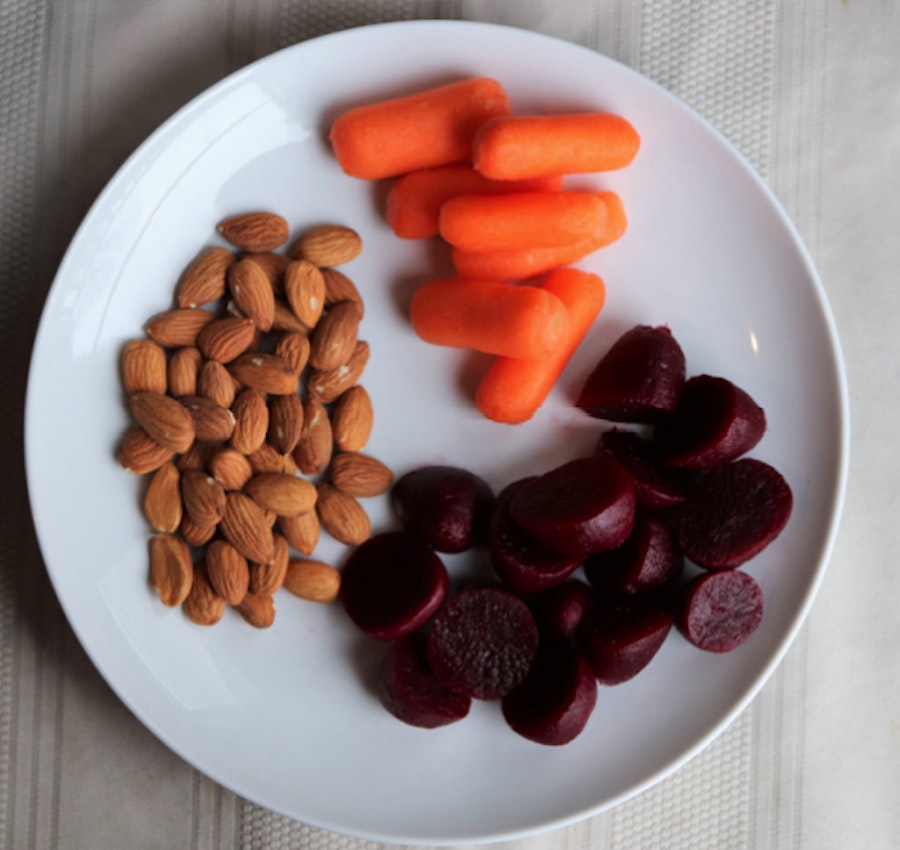
- 85 g carrots = 6 g net carbs
- 47 g almonds = 5 g net carbs
- 136 g beets = 9.2 g net carbs
- Total: 20.2 g net carbs
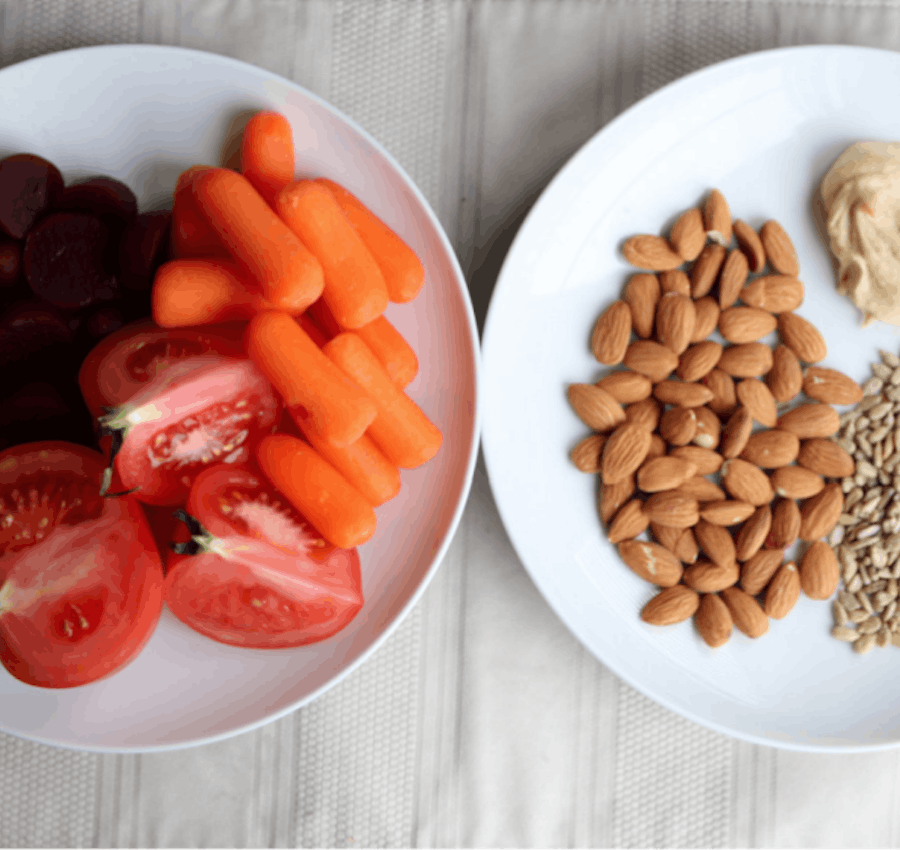
- 250 g tomatoes = 7 g net carbs
- 170 g carrots = 12 g net carbs
- 136 g beets = 9.2 g net carbs
- 30 g sunflower seeds = 3 g net carbs
- 42 g hummus = 5 g net carbs
- 56 g almonds = 6 g net carbs
- Total: 42.2 g net carbs
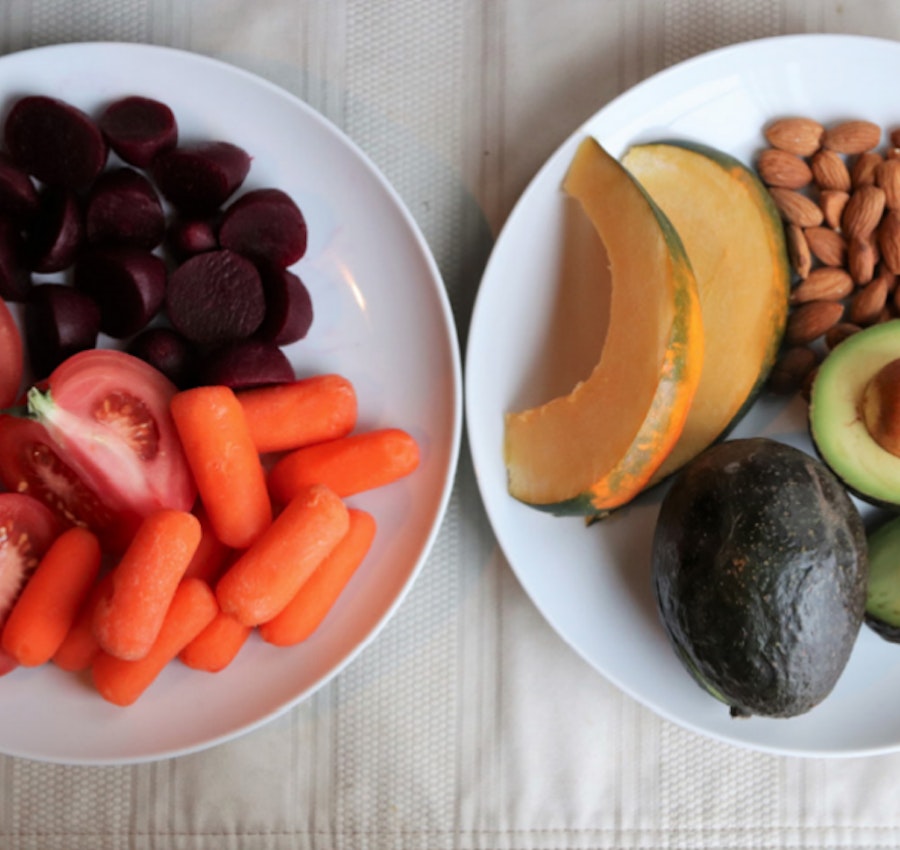
- 170 g carrots = 12 g net carbs
- 136 g beets = 9.2 g net carbs
- 250 g tomatoes = 7 g net carbs
- 2 medium avocados = 8 g net carbs
- 56 g almonds = 6 g net carbs
- 100 g acorn squash = 8 g net carbs
- Total: 50.2 g net carbs
Vegetables
This is the category of foods you will not want to restrict.
I recommend consuming
- 7–10 cups of salad per day, or
- 4–6 cups of other vegetables like broccoli, Brussels sprouts, etc. If you are doing cruciferous vegetables, steaming or slightly sautéing is recommended; and as a special note, more antioxidants are released when you slightly cook them.
If you go shopping for salad, realize that one cup equals 1 ounce. To give you a reference, bags of salad are often 5 ounces (five cups), and plastic containers are also 5 ounces.

Consuming large salads with spring mix, spinach, arugula or even cabbage will start to give you the nutrients that help undo insulin resistance. There are numerous studies demonstrating that various nutrients—vitamins A, B, C, D and K, potassium, magnesium and chromium—improve insulin balance, which is the icing on the cake. (Sorry, I couldn’t resist that one.) Below are some examples of amounts of salad.
Below are some examples of amounts of salad.

The fiber in the leafy greens will feed your gut microbes. They in turn convert the fiber into butyrate (a type of fatty acid), which lowers your insulin and helps you lose weight. Although fiber is a carbohydrate, it has zero effect on your insulin levels. The greater the diversity of vegetables, the more wide-spectrum your microbes will become.
CAUTION
If you bloat from vegetables, steam them or reduce the amounts until you have no bloating. Bloating will reduce your results.
Protein
On average, you will be consuming 3 to 6 ounces of protein at each meal. What does this look like? See below.








If you are starting with three meals a day, here are two examples of how much total protein you could eat in one day.

Fat Amounts
When you calculate 70 percent of your total calories per day, the fat may initially seem like a lot. However, because fat has more than double the calories of the same volume of proteins and carbs, it’s not that much.
Here are a few examples of what total fat for the day looks like:

What Do I Avoid?
Sugar
You will need to reduce your carbs down to between 20 and 50 grams, and your dietary sugar down to zero! There are acceptable sweet alternatives. The three that I recommend, which are easy to get, are stevia, non-GMO erythritol and non-GMO xylitol.
Avoid
You will need to reduce your carbs down to between 20 and 50 grams, and your dietary sugar down to zero! There are acceptable sweet alternatives. The three that I recommend, which are easy to get, are stevia, non-GMO erythritol and non-GMO xylitol.
Avoid Grains and starches

You have to avoid ALL grains, including oats, wheat and barley. Quinoa, although a seed, should also be avoided.
Exception: Small amounts of Finn Crisp Thin Rye Crispbread, a brand of rye crackers that only has 4 grams of sugar. This is net carbs, which is the total carbohydrate minus the fiber. The product is non-GMO, and in low quantities it does not seem to negatively affect ketosis.
Starches to avoid include white and red potatoes, sweet potatoes, yams, white and brown rice, corn (even though it’s a vegetable) and cornstarch.
Fruits
Fruits to avoid include apples, bananas, pineapples, pears, dates, figs, grapes (and raisins), as well as fruit juices (orange, grape and apple juice—even tomato juice).
Exception: Small amounts (one half to one cup) of berries per day.
Legumes (beans)
Legumes to avoid include beans.
Exception: Hummus.

Intermittent Fasting
Intermittent fasting (IF) is not a diet. It is limiting the frequency of meals, allowing you to rely on fat burning for all the time between meals and while you’re sleeping at night.
RULE: DON’T EAT IF YOU ARE NOT HUNGRY.
This is important because one of the primary triggers of insulin is eating— eating anything. Eating five to six times a day—and let’s not forget snacking— will spike insulin. Frequent eating throughout the day causes chronic sustained higher levels of insulin.

Eating less often with no snacks to spike insulin in between meals is the most powerful way to correct insulin resistance. To do this, first start with three meals per day—NO snacks—absolutely nothing between meals but water, black coffee and other non-caloric, non-insulin- spiking drinks. (Too much coffee, however, will also spike insulin.)

Keeping insulin at a normal level between meals and during sleep allows the pancreas to rest and recover. However, some people have a hard time going from one meal to the next because they experience blood sugar crashes and severe hunger.
The solution to this is to consume more fat during the meal, fats from butter, healthy oils, cheeses like cottage cheese, etc.. Fat not only satisfies you the most; it triggers insulin the least. Consuming lean protein and low-fat meals keeps you hungry, so the answer is more fat.
The goal over time is to gradually transition from three meals per day to a shortened daily eating window of only two meals per day.

This is not about lowering your calorie intake; it’s about eating less often. Your new goal should be to reduce the frequency of meals you eat and avoid spiking insulin. Again, low-calorie diets do not work because they keep you hungry and craving—even worse, they deprive you of nutrients, eventually slowing your metabolism. If you’re transitioning from three to two meals, make sure those two meals contain the same calories as the three meals.
As you adapt, which is called keto-adaptation, it will be easier to go longer before your first meal. Continue to shorten your eating window as gradually as you can, as seen in the diagram below with a four-hour eating window. There are many different meal schedules you can use based on the demands of your life.

It is okay to be a little hungry as long as it does not impair your cognitive function or cause headaches or weakness. Allow your body to adjust to running on fat. For some true sugar junkies, this can take a few months. But your cells will eventually adjust, and you’ll enter full fat-burning mode. Then it gets really easy to resist snacking because you have no cravings and are not hungry anymore. When you see the weight simply melting off, this will motivate you to stick to your new way of eating.
I’ve found that at first you’ll need more fat with meals; however, as you burn more of your own fat, you’ll need less. Some people decide to even do one meal per day, especially if the thyroid is very slow. But with one meal a day, just make sure the meal is a robust one, containing all the needed nutrients to fortify your body with vitamins, minerals, amino acids, those important fatty acids, trace minerals—all of it. (This can be aided with green drink powders and high-quality electrolyte supplements that will help you get your daily requirements for potassium.)

What Are the Benefits?
Keto-Adaptation Side Effects
Your body is going to have to switch fuel sources and will need a new cellular process to accomplish this. When you follow this plan, your cells will change over and adapt, which usually takes between three days and two weeks. It all depends on how serious your insulin resistance is.
During this adjustment phase, you might experience some of the following symptoms:
- Keto flu (feeling run-down)
- Fatigue
- Irritability
- Muscle cramps
- Kidney stones
- Sleep problems
- Constipation
- Keto rash
Apple Cider Vinegar (ACV)
Take 2 tablespoons of Apple Cider Vinegar (ACV) in a 16-ounce glass of water. Add some lemon juice (2 Tbsp) and drink up. This will help the transition into fat burning and increase your digestion and energy. Lemon can also decrease any risk of kidney stones if you are susceptible.
B Vitamins (Nutritional Yeast)
Doing ketosis requires more B vitamins to allow the energy factories (mitochondria) to do their job. Nutritional yeast provides a good natural source. Make sure your nutritional yeast is not enriched with synthetic B vitamins. I do recommend my version, which comes in tablets (Nutritional Yeast). You’ll notice this will greatly help you with exercise and having more endurance. When someone is deficient in B vitamins, they can experience fatigue and more stress.
Potassium (Electrolytes)
The body requires key minerals when doing keto, specifically potassium and magnesium. However, you should never take only one mineral without the related ones, as it can create an imbalance. Using a high-quality electrolyte blend is recommended.
My brand comes with all the electrolytes but in the ratio that matches most people’s deficiencies, with super-high potassium, good amounts of magnesium, and lower amounts of sodium and calcium. It also comes with trace minerals and contains no maltodextrin. When you are deficient in potassium and magnesium, you can notice fatigue and a lack of endurance.
Frequently Asked Questions on Ketosis and Intermittent Fasting
What is a ketone?
A ketone is a byproduct of fat being burned in your body. It is basically a source of energy (fuel) that is an alternative to glucose. Ketones are the preferred fuel for the body and are more efficient for the brain and the heart.
How long before I start losing weight?
Often people want weight loss to start happening right now. Your body has been running on glucose for your entire life, though. Your cells have to build new enzymes—a whole new cellular machine—to break down fat as a new source of fuel. However, you should start experiencing fat loss in three days, then more and more as your body becomes a fat-burning machine.
Once you get there, you won’t have sugar cravings anymore. You’ll have better blood sugar. Your memory will be sharper, and you’ll urinate less at night and sleep better because your blood sugar won’t be plummeting during the night after sugar spikes.
I started the keto diet about a week ago. Now I’m tired constantly. What do I do?
As your body adjusts to fat burning, you will need more B vitamins. The nutrient you need a lot of to keep the fatigue away and help your adrenals and metabolism is B5. A sodium deficiency could also produce fatigue and weakness.
Can I eat beets, peas, tomatoes, corn and potatoes on a keto diet?
Starchy vegetables like beets, peas and carrots can be eaten in small quantities because they are rich in fiber, which reduces the insulin spike. Tomatoes are moderately sweeter and can be consumed in higher amounts than these others; however, potatoes and corn must be eliminated.
What kind of liquids should I be drinking that won’t interfere with ketosis?
- Filtered or spring water.
- Bone broth is good—even during the fasting period between meals. Too much can slow ketosis for some people.
- Homemade sodas with flavored stevia—these are great.
- Apple cider vinegar in water is good for helping you manage insulin and also for overcoming insulin resistance.
- Unsweetened almond milk.
But avoid alcohol and even coconut water.
Is coffee okay on the ketogenic diet?
Sure, if you’re having about one 8-ounce cup per day, not 15 cups. The problem with coffee is that it is the third most sprayed crop in the world, and it depletes the adrenals. If you’re going to drink coffee, make sure it’s organic, that the creamer is organic, and that you use xylitol, which is GMO-free and tastes just like sugar.
What about Bulletproof Coffee?
Bulletproof Coffee is coffee with added grass-fed butter and a fat called MCT oil, which is extracted from coconut oil. If you want to use that as a meal, fine; but it can trigger insulin a little. That being said, I think it is good to do in the beginning, as it reduces hunger. However, for some people it could slow progress; so experiment.
What are the best supplements to take while on keto?
There are several of my supplements that I recommend for various situations, all of them found on my website
Electrolyte Powder: This is loaded with potassium, magnesium, chlorides and trace minerals to provide your cells with the right nutrients.
Blood Sugar Support Formula: This supports healthy blood sugar levels to enhance the ketosis state.
Nutritional Yeast: This has all the B vitamins you need and more.
Wheat Grass Juice Powder: This is packed with vitamins and minerals as well as phytonutrients.
Can I chew gum?
This is a minor concern, but yes. You should choose (sorry, bad pun) xylitol gum.
Can I have a cheat day?
No. If you want to get into ketosis and stay there, you need to stick to the plan. It can take over a week to get back into ketosis after a sugar slip.
Can my cholesterol go high on a ketogenic diet?
When you lose weight, fat cells shrink. In a fat cell, there are triglycerides and cholesterol. Now, as that fat cell shrinks, you can burn triglycerides, but you cannot burn cholesterol.
So it will go into the blood, go to the liver, and come out through the bile. But you’ll be totally fine as long as your triglycerides are low. (If you’re not using those as fuel, then you’re eating too much sugar.)
What can I do about ketosis and constipation?
There are many scenarios that can cause constipation with the ketogenic diet. Most people assume it’s a fiber issue, but it’s not that simple. You want to compare what you were doing before ketosis and after.
Look at the change in vegetable fiber consumption. If you don’t have enough gut bacteria to digest all these vegetables, they will cause bloating, constipation, gas and all kinds of digestive issues.
Some people can do vegetables and others can’t, of course. Some people can’t do cabbage; others can’t do cruciferous. So you might have to switch to less fibrous vegetables for your potassium, such as various kinds of lettuce, and especially kale and beet greens.
Electrolytes greatly assist with constipation too. If you need more electrolyte support, try my Electrolyte Powder. It helps supply the required 4,700 mg/day of potassium, which is hard to manage without high vegetable consumption.
What is ketoacidosis? Is this good or bad?
Ketoacidosis is a very dangerous condition that happens only when you’re a type 1 diabetic and completely stop making insulin. This results in raising your acid levels far beyond normal. However, Healthy KetoTM will not produce acid levels even close to those of a ketoacidosis condition.
Can I do IF without doing a keto diet—or should I do both?
Well, if you’re doing intermittent fasting alone, but you’re eating lots of carbohydrates and not eating nutrient-dense foods, your skin, hair and nails will suffer. I recommend doing both, as they both complement the reduction of insulin.